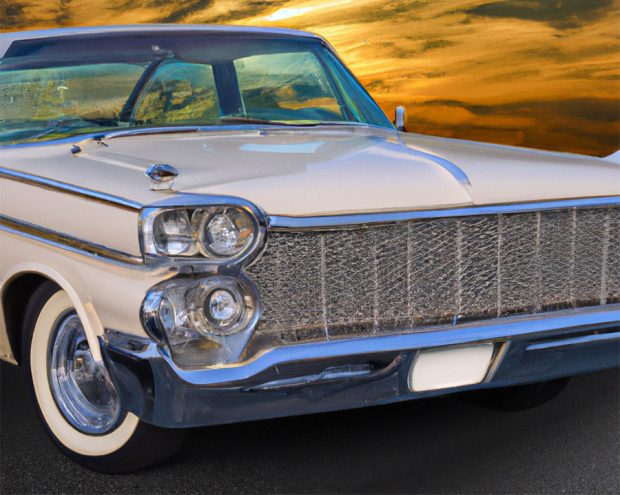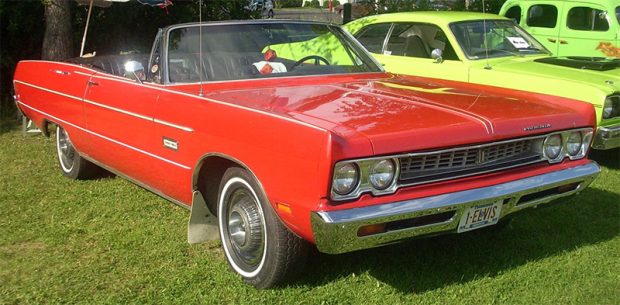
By Dave Ashton
The Plymouth Fury is a great example of a muscle car which was around for many years before the golden age of the late 1960s-1970s. Like many models of the time, it was slightly overshadowed by the more popular makes, but it still had all the attributes that make up a classic. Tracking the Plymouth Fury’s back history provides us with a rough road map of how the muscle car world came into being, and was ultimately squeezed and sanctioned to death by the mid-to-late 1970s. Below we will go through the Plymouth Fury’s back history, with some of the standout examples along the way.
The Plymouth Fury is a classic American car with character, style, and performance. With six generations total and two half-generations included, it’s no surprise that the 1959 Plymouth Fury has become a cornerstone of the vintage car market. Whether you choose one of the original two-door hardtops or a later mid-sized sedan, the Plymouth Fury is sure to make a statement on the road.
The Plymouth Fury was also renowned for its iconic grille, which featured three large slots located between the headlights. The front and rear end of the car were equally distinctive, with the hood scalloped to accommodate the engine and tailfins that ran the length of the car. The interior was spacious and luxurious, with a full instrument panel and ample storage space.
It wasn’t until the early 1960s that the Fury was treated to muscle car like power with the 426cu Wedge and Hemi V8, then having this styling redesigned to fit in with the muscle car era.
Generations

The Plymouth Fury began life in 1955 and was produced until 1989. It began as a sub-series of the Belvedere, then became its own model for 1959 and remained so for the remainder of its run. Changes to the model over the years included body sizes and engine options, such as the 350cu. V8 Golden Commando was equipped with twin four-barrel carburetors producing 305 hp (227 kW). The 1959 Plymouth Sport Fury and the 1966-1969 Plymouth VIP are also part of this model’s extensive history.
The first generation Plymouth Fury featured a hardtop with aluminum trim in 1956 and 1957, and a buckskin beige paired with gold anodized aluminum trim in 1958. There were special interiors, bumper wing-guards, and the option of the Golden Commando V8. This setup was eventually recalled and replaced with a conventional dual 4-barrel setup. Other 1958 options include the 318 cu in (5.2 L) V-800 Dual Fury (with 4 and 2-barrel options) and the 315 hp (235 kW) fuel injection option.
The second generation Plymouth Fury was produced in 1959 and 1961, and featured a convertible and several 4-door and 2-door models. The station wagon version of this model was known as the Sport Suburban and was not marketed as a part of the Fury series. Additionally, a 1959 Dodge Viscount was offered based on the Fury but featured a 1959 Dodge front clip.
The third generation was introduced in 1962 and featured a 2-door Sport Fury which was reintroduced after being dropped at the end of 1959. This Sport Fury was discontinued in 1971. The 225 cubic inch (3.7 L) Slant Six and 318 cu in (5.2 L) V8 remained from the prior generation, while the 361 cu in (5.9 L) V8 and 350 cu in (5.7 L) V8 were available as options.
The fourth generation was produced from 1965 through 1974, offered as a full-size car and available as a 4-door sedan, 2-door hardtop and 4-door hardtop. Some of the fifth-generation 1975-1978 mid-size cars have been assigned to the fourth generation, though this discrepancy was caused by the production gap between 1978 and 1980 when there was no large Plymouth.
The fifth and final generation Plymouth Fury was the Gran Fury from 1980-1981, followed by the M-body from 1982-1989. It was the last V8, rear-wheel-drive Plymouth, and the last one off the production line was made on December 23, 1988.
The sixth and final generation of the Plymouth Fury marked the end of an era for the classic American car. Despite being discontinued for over two decades, the fury remains an iconic model that still commands attention and appreciation. Classic car aficionados still seek out pristine examples of this classic model, while modern restoration experts enjoy bringing them back to their former glory.
The Plymouth Fury was also available with numerous performance options including power brakes, power windows, air conditioning and a special cruise control system. Furthermore, buyers could opt for the upgraded Sport Fury package, which added bucket seats, a center console and additional trim.
Throughout the years, various motorsport teams have used the Plymouth Fury to great success. One of the most successful was the Bob Glidden Pro Stock team, which piloted the car in the National Hot Rod Association’s Super Stock class during the 1970s and 80s. The team competed with a highly modified version of the Fury, dubbed “Fury Monster”.
In addition to its presence on the racetrack, the Plymouth Fury was a popular choice for film and television productions in the 1960s. The most famous example is Stephen King’s Christine, which featured an 1957 Plymouth Fury as its protagonist. The movie sparked renewed interest in the classic model and has since gone on to become a cult favorite among car enthusiasts.
Today, the Plymouth Fury is still appreciated and sought after by classic car enthusiasts, who often look to upgrade their existing vehicles with new parts and modifications. While the car is considered a classic, many aftermarket companies still produce performance parts for the model as well as reproduction body parts and chrome trim pieces.
In addition to these aftermarket parts, there are many car clubs devoted to the Plymouth Fury. Members of these clubs often take part in car shows designed specifically for the Fury, or participate in drag racing competitions with their fully-modified Furies.
In recent years, the Plymouth Fury has taken on a life of its own as a vintage car, with collectors and enthusiasts alike seeking out original models for their collection. From its classic good looks to its long list of performance options, the Fury is sure to remain one of the most iconic and beloved cars ever produced in the United States.
No matter what generation you’re looking for, the Plymouth Fury will make an impression. Whether it’s a classic two-door hardtop or a sharp mid-sized sedan, the Plymouth Fury offers timeless style and performance that will never go out of fashion.
VN:F [1.9.22_1171]
VN:F [1.9.22_1171]
Source link


